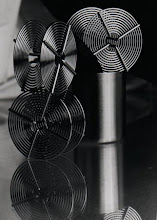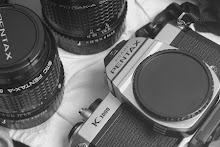
In order to get my small enlarger to print horizontally, I had to unbolt it from the baseboard and clamp it in a vise-horse (sawhorse with a wide vise for a top surface). This held the enlarger so that the lens pointed horizontally towards a big foamcore target-board that I had set up across the room. Any flat vertical surface big enough to attach the paper to will do.
The general pattern of the procedure is the same for other forms of black and white printing. The primary differences include: the enlarger is aimed horizontally, to have clearance to make the projection; the large sheet of print paper is developed in solutions held in wallpaper trays instead of ordinary developing trays; some advance preparation and rehearsal helps make this unusual task go smoothly because an unusual amount of darkroom time will involve total darkness instead of safelight.
Enlarger focus and exposure and test stripping will all have to be done before you start wrangling the big sheet of paper.
To hold the enlargements to the easel, I used blue tape. My procedure was to tape off an area on the target-board easel (I had to print horizontally in an improvised fashion), to minimize the amount of time or hand motions required to interact with the print paper.
I had some strips of tape stuck to my pants. I say tape on my pants because in the total darkness, holding the roll of paper, I could not hold the roll correctly against the target board and still move my hands around enough to use the roll of masking tape in the dark. So, I got into the habit of tearing strips off and sticking them to things where they would be easy to remove. One of those surfaces was my pants. Stage some tape strips.
I rehearsed with a roll of ordinary paper cut to size before I tried the print paper. With my improvised rig, I almost had to. It helped me figure out the tape strip staging, and what the masking tape on the target board would feel like.
I used masking tape to mark off an area on the easel/target board; I could feel the paper tape; that touch contrasted with the smoothness of my target board. Later, I also used tape to hold the print in place onto that board. So, there was a lot of tape involved; but, I had to do this completely in the dark, so I had to do it all by feel.
I cut the photo paper to a larger size than I needed for the final print. This gave me room to move. I had about two inch margins at either end. This was a lot, but it helped for the first few.
I would begin the printing itself with the print paper cut to size and in some opaque bags. I would carry it over to the easel.
I would take the roll out of the bags. I would hold the roll (emulsion inside the curl, as natural for the paper) up to the easel. I would back off my grip on the roll about an inch or two. This meant the print paper was in a roll, and there was a flap. The back of the paper to the easel; I would tape it down. First, I would only tape the corners, in case I was misaligned.
Then, I would unroll the paper down the target board. I would tape down the bottom corners. Unroll slowly and smoothly. It will be at the ends of the unrolling that the curl will try to interfere most with your picture.
With the corners taped down, I would feel along the edges of the print paper with my fingertips. My target area had been taped off into a rectangle. Also, I had taped off marks where I thought the corners of the paper would fall. In total darkness, I would use touch to inspect the paper.
If it was off, adjust the position by the worst corner. It's this aligning and adjusting in the dark with improvised equipment that meant I had to allow for some overlap at the ends. Gives you margin of error, literally.
Well, corners down in place, I would use tape strips off of the legs of my pants to hold down the print paper.
With the corners taped down, I would feel along the edges of the print paper with my fingertips. My target area had been taped off into a rectangle. Also, I had taped off marks where I thought the corners of the paper would fall. In total darkness, I would use touch to inspect the paper.
If it was off, adjust the position by the worst corner. It's this aligning and adjusting in the dark with improvised equipment that meant I had to allow for some overlap at the ends. Gives you margin of error, literally.
Well, corners down in place, I would use tape strips off of the legs of my pants to hold down the print paper.
With the paper secured, you can then back off an make your exposure. Then, get the paper; I found it would help to remove the tape edge, then corners, then roll to the other end, then far edge, then corners. Idea there is to keep one end secure as you get the exposed, but undeveloped print rolled back up to move to a light-tight container or to development tray.
Developing in wallpaper trays was easy and fun. It was interesting to see the solutions run down the exposed paper and begin to reveal the image inside. The only difference about the wallpaper trays as trays themselves was their size and shape. The largest trays I could get had a 32” inner clearance. I thought this would be enough for a 30” print, but discovered during processing that it helped to have about two inches of clearance on both sides (prints were 30” on the long side).
With a few liters of photosolutions in there, the wallpaper trays worked great. You just roll them in and roll them out and roll them back in. I even learned to change it up so that both ends would get their turn at the center of the roll. It was fun and easy. Just keep the print slathered in solution, and it'll do its stuff.
I know my method doesn't sound fancy, but it worked well. I even showed my little sister how to make a print while I was using this technique.
Proceed with confidence! J.






Remember, Tape!
ReplyDeleteI just had this idea for using wallpaper trays for big print development and figured I wasn't the first to think of it.
ReplyDelete:)